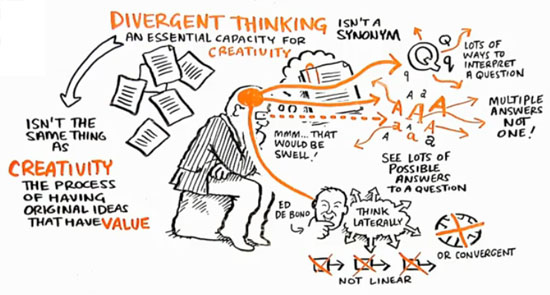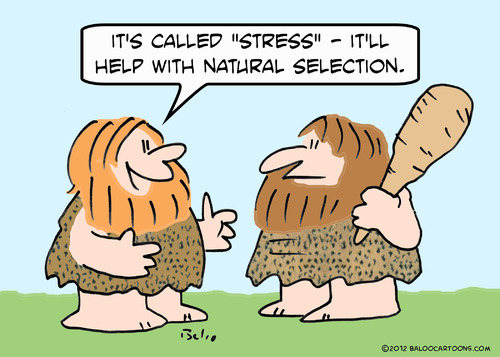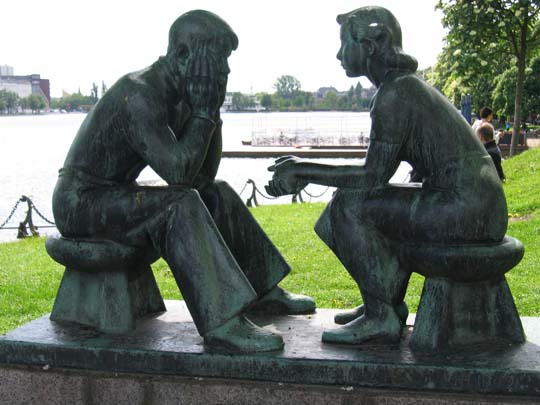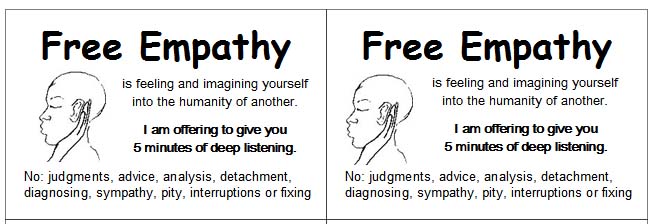What surprised him most about the class, however, were the times when we diverged and connected people, events and concepts that seemed far ranging and even, "off-topic." Sometimes these connections would take the form of creating analogies that seemed to contain portions of what we were exploring. Other times, we would have "metaphor practice" to try to construct a metaphor that described an historical event as fully as possible using our own experience. At the highest levels of thinking, analysis and metaphor meet as the critical and creative forces that make for original thought. To permanently separate them is to create a false dichotomy that chokes off imagination. I like to think that I was just trying to get Carl ready for a career in science (or whatever) by following the dictum of evolutionary biologist R. C. Lewontin, "It seems impossible to do science without metaphors."
As I was responding back to Carl's note I was reminded of one of the first times I ever thought about divergent thinking in this manner. I had made the conscious move to change schools from a rural all boys boarding school to an urban co-ed day/boarding school. Other than in summer schools, it was the first time I had taught girls, and it was remarkable to me how much more the girls' thinking was connected to both their own experiences as well as to other stories while they talked in class.
This led me to start listening for "how" someone was saying something rather than only "what" they were saying. It is this added level of listening that is one of the cornerstones of shifting from thinking about teaching as being solely about the transmitting of information to examining teaching as also encompassing the exploration of how what is being transmitted is being received. Once you make this transition, it is like Alice falling down the rabbit hole or Dorothy waking up in Oz--a world full of talking scarecrows and mad hatters that consistently resists full comprehension. (I explored another form of this phenomenon in an earlier post on "The Hedgehog and the Fox.") It is has been one of the most profound paradigm shifts in my understanding of what I am doing in a classroom.

The confusion induced by my paradigm shift was compounded as I realized that having a full class of people who were ALL using different techniques to process what we were discussing was overwhelming and exhausting. But it also felt exciting every day because even if you had taught something before (I am up to having taught The Great Gatsby over forty times), you could never predict HOW a student was going read a book.
I began to to investigate this phenomenon and, in a serendipitous moment, I discovered the Stone Center at Wellesley College. It was the work of Jean Baker Miller, the founder of the Stone Center, on the psychology of women that first drew my attention, but in the same year I had shifted schools a book appeared called Women's Ways of Knowing that made me re-think (and subsequently expand) the way I had been thinking about teaching. The discovery that Blythe McVicker Clinchy and her colleagues documented in that book was that there were identifiable epistemological levels to the way students engage material they are learning. I remember being so excited that I made my newly formed interdisciplinary course in Philosophy and Literature read the whole thing.
Clinchy discerned that there were levels of understanding that could be described and that were common to all students. But the real discovery, form my point of view, was that men and women appeared to have different techniques of making meaning at the upper levels of the stages. In short, men and women showed similar approaches in early stages of learning until they came to the level of "procedural knowledge." When people are in this stage they are asking questions about the accuracy and worth of the information they are receiving. Is Nick a reliable narrator in Gatsby? Does Jefferson really believe what he wrote in the Declaration?
In other words, learners in this category were engaged in a reasoned reflection about the nature and authenticity of authority. Clinchy posited that in this stage there were "separate knowers" and "connected knowers." The former detached themselves from what they were studying, tried to remain objective and were often willing to argue and debate about whether something was reasonable. These were predominately male. Connected knowers, however, were more likely to try to empathize with the source's point of view, to see the source in its real world context and to connect the source to their own experience. These learners were predominately female. Obviously, I wanted my students to be able to do both, but it seemed to be true that most students, like Carl, favored one form--separate or connected-- over the other.
But it was when I started teaching and coaching at a school out West that Clinchy's findings became even clearer. And it was not surprising for me that it was when I shifted from coaching boys to coaching girls in soccer that the difference between separate and connected knowers became most vivid--and most useful. Sports---like theater and music and all of the arts--are performance based activities and, as a result, you get immediate, real time feedback about whether something has been learned or not. Did the ball do what you wanted it to do? Did you hit that note, or not?
Furthermore, the more confident you were, the better you performed. But where did that confidence come from? What was its foundation? What was immediately apparent to me was that it was different for girls than for boys. With a girls team the more they empathized, saw what they were learning in a larger context and connected it to their own experience, the more confident they grew, the more they developed technically and strategically, the higher the their level of intrinsic motivation and the more it meant to them. From that moment on my teaching, and my coaching, became both more varied and more focused at the same time whether it was with boys or girls.
The point, however, is not that one way of procedural learning--separate or connected--is better but rather that it is good to know the epistemological strengths of the people you are teaching (and coaching) as well as where you think they could grow in the future.
Finally, Clinchy's last level of learning--constructed knowledge--understands that learning is a process based on construction, destruction and reconstruction. These most sophisticated learners have a high level of tolerance for paradox, ambiguity and developed a narrative sense of self that tried to "establish a communion with what they are trying to understand." And being meta-cognitive--understanding the techniques that you yourself use to learn best--seemed to me to be a fundamental goal of any teacher or coach.
By the way, it turned out that Carl was a superb connected learner as well; he just hadn't done it much before.

















